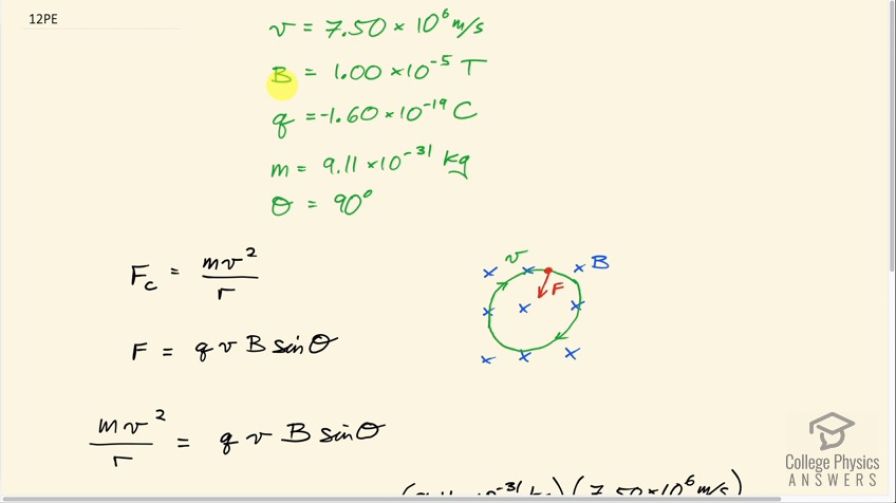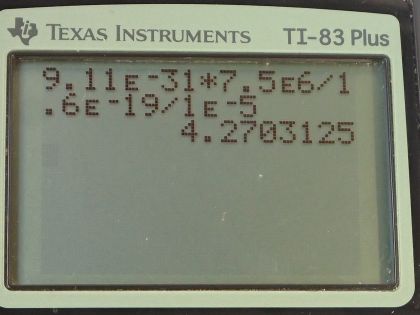Question
A cosmic ray electron moves at perpendicular to the Earth’s magnetic field at an altitude where field strength is . What is the radius of the circular path the electron follows?
Final Answer
Solution video
OpenStax College Physics, Chapter 22, Problem 12 (Problems & Exercises)

vote with a rating of
votes with an average rating of
.
Calculator Screenshots
Video Transcript
This is College Physics Answers with Shaun Dychko. A cosmic ray electron is moving around in the Earth's atmosphere at an altitude such that the magnetic field strength is 1.00 times 10 to the minus 5 tesla's, it's moving around in a circle and that means it's moving perpendicular to the Earth's magnetic field direction so let's draw it hypothetically such that the field is going straight down so we are in space looking towards the Earth maybe near one of the poles here and this electron is moving in this clockwise direction and the force will be centripetal meaning it will be directed toward the center. So you can verify that by putting your fingers in the direction of the magnetic field using your right hand and then your thumb points in the direction of motion of the particle and your palm is facing the direction of the force on a positive charge. Now because this is an electron, its charge is negative and so the force is in the opposite direction and so with your right hand, you can verify that the back of your hand is pointing towards the center of this circle. Okay! Now because this is an electron, we also know what its mass is we can look up the mass of an electron using a search engine if you like— 9.11 times 10 to the minus 31 kilograms— and the elementary charge on an electron is negative 1.60 times 10 to the minus 19 coulombs and we are given its speed and we are given its magnetic field strength. So the centripetal force for any particle moving in a circle is its mass times its speed squared divided by the radius of the circle and this force is being provided by the Lorentz Force— that's the name for this force on a moving charge particle due to a magnetic field— which has a magnitude of the charge multiplied by its speed times the magnetic field strength times sin of the angle between the two. Now if we took a side view of this, we would see the particle moving sideways and the field straight down and these are perpendicular so this is taking this and moving this, you know, towards you and this away from you to get a side view. Okay! So we can equate these two— centripetal forces being provided by this Lorentz Force— and solve for r by multiplying both sides by r over qvBsin Θ and then switch the sides around and we have r equals m times v to the power of 1 because this v squared divided by v is v to the power of 1 divided by qBsin Θ. So that's the mass of an electron multiplied by its speed divided by the charge in the electron and just using the magnitude here... there's no meaning to a negative radius and this is just a magnitude of the force so positive 1.60 times 10 to the minus 19 coulombs will do there times the magnetic field strength times sin of 90 degrees and we get 4.27 meters is the radius of this circle.
Comments
couldnt you just use the formula m=rqb/v and get the same answer without using the angle?
Hello, thank you for the question. The formula you're suggesting assumes an angle of , so it works out the same as the formula in the video since the sine of in the video formula is 1. Either formula is fine in this case, but the formula you're suggesting applies only to the special case of between the magnetic field and velocity of the charged particle.
All the best,
Shaun


